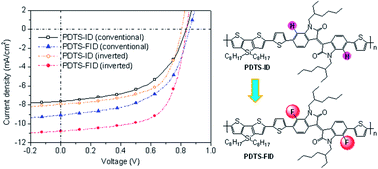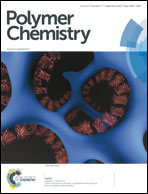Low band-gap copolymers derived from fluorinated isoindigo and dithienosilole: synthesis, properties and photovoltaic applications
Abstract
A low band-gap copolymer, PDTS-FID, containing alternating dithienosilole (DTS) donor blocks and fluorinated isoindigo (FID) units, and its non-fluorinated counterpart, PDTS-ID, have been synthesized and characterized for photovoltaic applications. Compared to PDTS-ID, its fluorinated counterpart, PDTS-FID, exhibits broader and stronger absorption, lower-lying HOMO and LUMO energy levels, and higher hole mobility, resulting in an improved open-circuit voltage (Voc), short-circuit current density (Jsc), fill factor (FF) and power conversion efficiency (PCE). The positive effects were attributed to the fluorinated isoindigo block which favored a linear and planar conformation, giving rise to better backbone packing of the related copolymer, which was also confirmed by theoretical calculations (DFT). The conventional and inverted devices were fabricated and evaluated to explore the photovoltaic properties of the resulting copolymers. The best performance of 5.79% PCE was obtained from an inverted polymer solar cell (PSC) using PDTS-FID as the donor material, with a Voc of 0.84 V, a Jsc of 10.77 mA cm−2 and a FF of 0.64. These low band-gap copolymers could be expected to be promising donor materials for application in PSCs.


 Please wait while we load your content...
Please wait while we load your content...